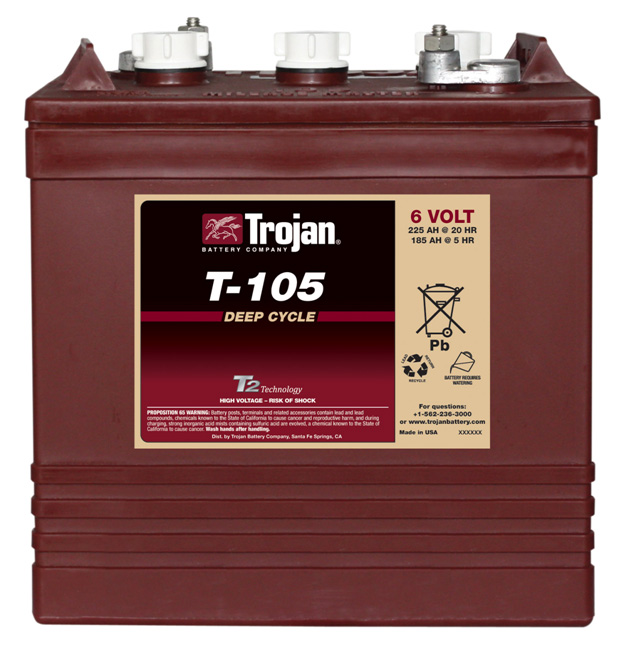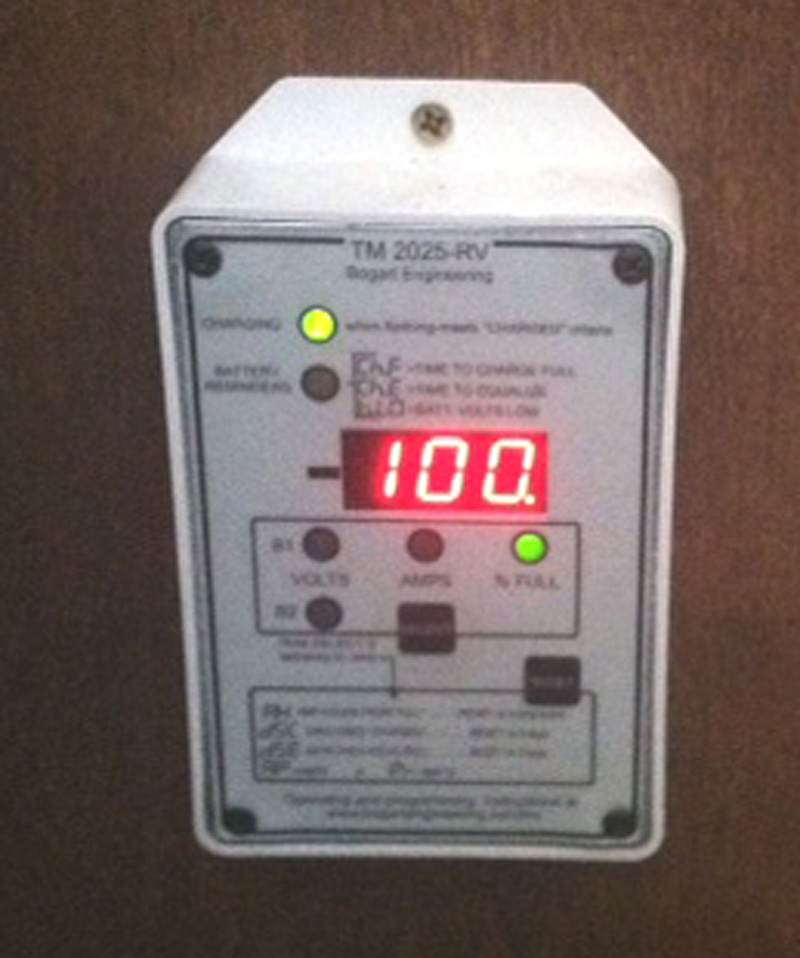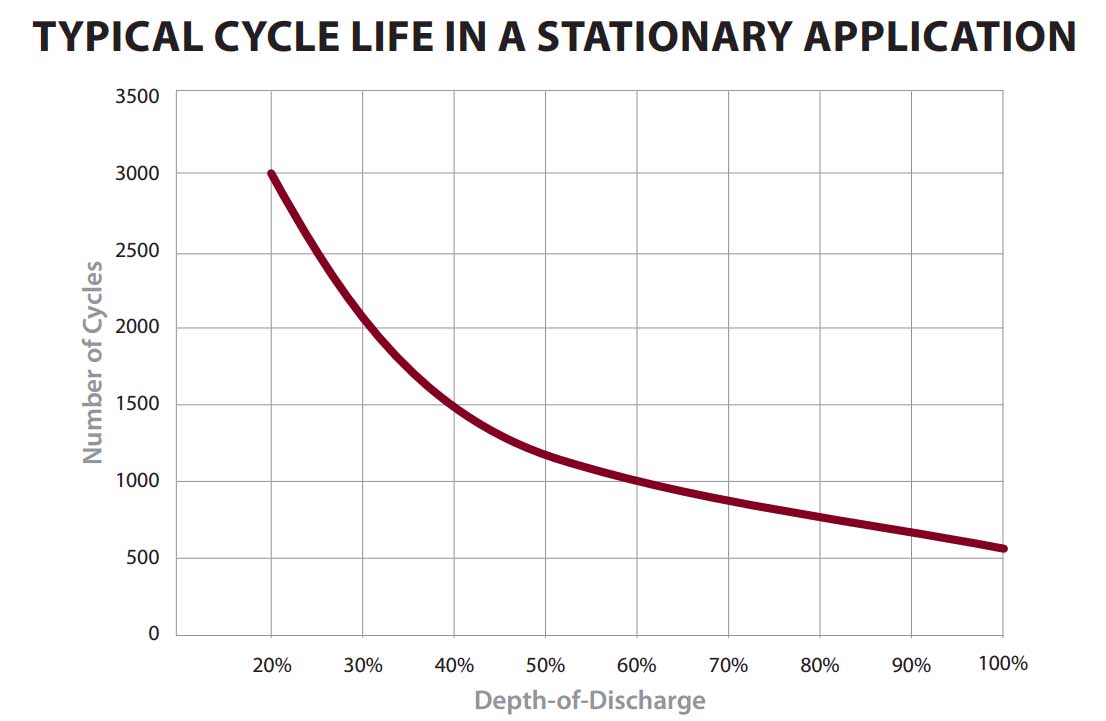It has been almost five years since we bought our Milan 26RLS travel trailer. Hard for me to reconcile the fact that each year seems to accelerate faster and faster towards the end of the game. When we bought this trailer it replaced our 2006 Fleetwood Niagara that had been “totaled” by our insurance company when vandalizing thieves destroyed it.

That whole process meant we didn’t go camping all summer. Once we got our new Milan the first order of business was to install a solar system and other electrical upgrades prior to its maiden voyage. At the time I was working so there wasn’t a lot of time to shop for the needed materials and components. Fortunately the best deals are on the internet if you know what you really need. There is one exception: batteries. Since 6 volt deep cycle batteries weigh over 60 lbs. each, in 2013 shipping costs made the internet cost of lead-acid batteries prohibitive. Not having a lot of time, and no local retailers close by that sold Trojan brand batteries, I compromised and bought a pair of Exide 6 volt golf cart batteries. At best, at the time, I hoped they would last for 5 years.
Most major brand deep cycle batteries are pretty good but I prefer the Trojan brand. The 6 volt T-105 golf cart batteries are almost legendary for long life and reliability. These are conventional flooded lead-acid batteries. Connected in series, two Trojan T-105 golf cart batteries will become a 225 amp-hour 12 volt battery bank suitable for most RV users. The Trojan Battery Company has been in business for 90 years and their website provides more technical data than any other battery manufacturer I have researched. Also Trojan publishes some of the test results on their batteries that have been tested by the well-respected independent battery testing laboratory, JBI Corporation. Most of the competition seems to get their technical information from their marketing departments.
So, I prefer Trojan batteries and my next set will be Trojans. This is not to say the major competitors don’t make good batteries; they do. My preference is Trojan and the “who is best” argument may be along the lines of who is better, Chevy or Ford. In any event, if you are in the market for deep cycle batteries for your RV, you need to delve into the numbers (specifications) of the different offerings on the market so you can make an informed purchase decision. Crown and US Battery have good reputations, but I have never used either.
Science
To truly understand batteries we need to understand the science behind them. I’m not a scientist, so the explanations here are going to be somewhat “un-scientific.”
Are Flooded Lead Acid Batteries the Best?
This type battery has been around for over 150 years. They work and they are a proven technology. When I first started working with car batteries over almost 50 years ago, these were the only kind available. Today there are more choices, such as Gel, AGM, and even lithium iron phosphate (LiFePO4 RV batteries, a.k.a. LiPo).
I’m not sure the LiPo technology is where it needs to be as it’s a fairly new technology. But the prices are astronomical, so they aren’t on my list. Usually a standard flooded lead-acid battery has a bit more capacity than a comparable GEL or AGM, and by a bit more I mean an almost negligible amount. A GEL battery is a Valve Regulated Lead-Acid Battery or VRLA (meaning it is sealed) and uses a gel electrolyte. AGM (absorbent glass mat) is similar to a gel and is also a type of VRLA battery and it is also sealed. GEL and AGM batteries require less maintenance and they cost more, plus the charging requirements differ from a conventional flooded lead-acid battery.
(Update 12/14/2023): This article is over 5 years old. Today LiFePo4 batteries have come way down in price, while almost everything else has gone way up, up, up. LiFePo4 batteries (these are not the kind of lithium battery we read about catching on fire). In 2022 I bought a 300AH LiPo battery and have been thrilled with the results.
With lead-acid batteries we generally don’t want to discharge them below 50% of capacity. This balances the life and cost. Completely discharging a lead-acid battery will probably ruin it. LiFeP04 can be completely discharged without damage, although the deeper the discharges the shorter the life span. Also at 50% discharge the voltage of a lead-acid battery is 12.0 volts; for a LiFePo4 it is 12.8 volts at a 50% charge. Lastly the number of charge cycles (life of the battery) is probably 5-10 times greater for LiFePo4.
Here’s the article I wrote about our LiFePo4 Battery installation.
In addition, this 3 Part Series on sizing an RV Solar System contains a lot of information about LiFePo4 batteries:
Sizing an RV Solar System Part 1
Sizing an RV Solar System Part 2
Sizing an RV Solar System Part 3
This website may be compensated for linking to other sites for sales of products. As an Amazon Associate I earn a small fee from qualifying purchases at no additional cost to the purchaser.
Is Less Maintenance a Good Thing?
So when I said GEL and AGM require less maintenance that means you don’t have to check the battery electrolyte level and add distilled water if it isn’t full – because you can’t – the battery is sealed. And since you can’t check the electrolyte level that means you can’t check the specific gravity of the battery cells, which I find to be a major drawback. When it comes to deep cycle batteries there are only two ways for the end user to test a battery 1) open circuit voltage and 2) the best method which is to test the specific gravity with a hydrometer. And this is why I prefer a flooded lead-acid battery – I can test the specific gravity of each cell.
Testing Flooded Lead-Acid Deep Cycle Batteries
It is easy to test the State of Charge of a battery. But to test how much real capacity a battery has as it gets older is just about impossible for the average user, and this is really what we need to know.
A fully charged lead-acid battery should have an open circuit voltage of around 12.6-12.7 volts. Open circuit means the batteries have no electrical loads, e.g., everything is turned off. However, my testing has shown that if deep cycle batteries are charged according to the battery manufacturer’s specifications the open circuit voltages are a higher than most of those specifications posted on the internet.
Not All Batteries Are Equal
Batteries develop their own “personalities.” Their location (very hot where I live), how much vibration they are subject to when traveling, how they are charged, how often they are discharged, how often they are charged and how well they are charged all contribute to a “personality” that is just a bit different than other batteries. This bit of difference is often due to the condition of the internal lead plates that we can’t see. The batteries still have to follow the laws of chemistry and physics, but the exact measurements in the “real world” often don’t match up to batteries tested in a controlled laboratory environment.
Most “internet” Open Circuit State of Charge Charts look like this:
So where did all of these charts come from and are they accurate for flooded lead-acid batteries? The answer is probably, “no one knows.” These charts sure don’t match up with what Trojan Battery Company says their batteries State of Charge is:
And both of these differ from my testing of our batteries over the years:
How Did I Arrive at These Numbers?
Actually it was pretty simple. Normally it takes some sophisticated equipment to do these kinds of tests. I do have the equipment to do it, but the procedure is time consuming to set up and test. Plus, since we have a solar system and an accurate battery monitor I don’t need the data. However, because I have a TriMetric battery monitor, the test was easy.
The TriMetric can be programmed to measure Battery % Full. The user enters the manufacturers amp-hour rating and then the monitor measures the amps in (from charging) and amps out from electrical consumers. The monitor then gives a real time status of the battery bank’s percent of amp-hour capacity left (down to single digits), such as 96% left.

With deep cycle batteries it is best to not go below 50% and better not to go below 80%. The higher you keep the Depth of Discharge, the more discharge cycles the battery can take over its lifetime.
So what I did was place a constant load on the battery, which I could measure with the TriMetric, and then I monitored the Battery % Full, recording the open circuit at 10% increments (100%, 90%, 80%, etc.) Once the monitor reached a 10% increment, I would shut off the system and let it rest for an hour, then record the Open Circuit Voltage. Then I would turn everything back on and run the next 10% increment.
What Amperage did I Want to Load the Battery With for My Tests?
Most deep cycle batteries have four capacity specifications:

Notice that the capacity is measured at the 5, 10, 20, and 100 hour rate. Also notice that the longer the hour rate, the higher the capacity. What does all of this mean?
Peukert’s Law
Peukert’s law states that the capacity of rechargeable lead–acid batteries differs according to the rate of discharge of the battery. The higher the discharge rate the lower the capacity, and the lower the discharge rate the higher the capacity.
The stated capacity of a battery in Amp Hour-Rate is based on Peukert’s Law.
So how do we determine the current used to calculate the amp-hour rate? We simply divide the manufacturer’s stated capacity by the hour-rate. The most commonly used number is the 20-Hour Rate, which we designate by the Capacity divided by the Hour-Rate.
Using the 20 hour-rate in the table above, we designate it as, C/20 or
C/20 = 225 amp-hours divided by 20 hours
C/20 = 225/20 = 11.25 amps
The average RV owner isn’t going to be running a constant 11+ amp load on the battery bank. But the C/20 capacity is good for comparing different batteries and it is much quicker to do detailed testing during a 20 hour span versus a 100 hour span.
Using my inverter to power the 110 volt household circuit in the trailer, I plugged in several lamps of different wattages until the TriMetric monitor showed the system was drawing 11.25 amps.
Is the State of Charge Voltage of Value?
To be honest, the State of Charge open circuit voltage isn’t very useful while one is camping. Who has the time or inclination to shut down the electrical system to measure the voltage? Plus over time, as the internal resistance of battery increases, the State of Charge voltage isn’t going to tell us how many amp-hours are remaining in the battery.
For me, it is just simpler to have a solar system that is adjusted to match the battery manufacturer’s charging parameters. I usually leave the monitor set at the % Battery Full function and I occasionally look at it.
What I Should Have Done
When I was testing the Voltage vs State of Charge, I should have recorded the battery voltage while under a load.
When a consumer is connected to a battery, the battery voltage reading decreases. An extreme example, which is not applicable to a deep cycle battery, is how we used to test starting batteries in a car. A car battery really only serves one purpose: provide large amounts of amps for a very short period of time to start the engine. Once the engine has started we don’t need the battery and the alternator recharges the battery while we drive so it can supply a large amperage current for the next starting event. Deep cycle batteries are designed to provide lower amperages over a long period of time. In fact, there is no “specification” to load test a deep cycle battery.
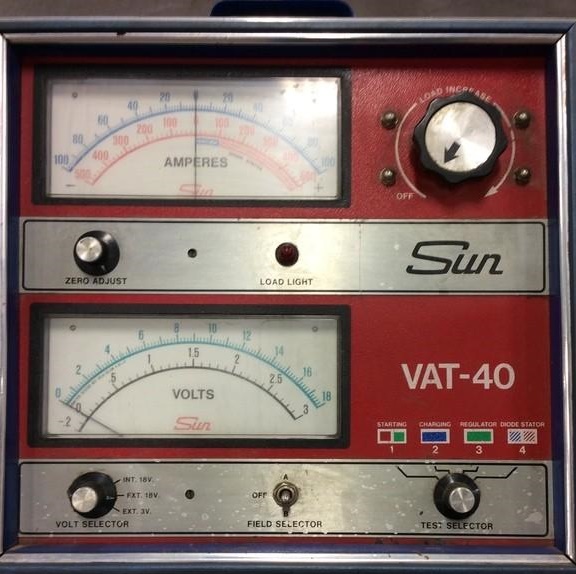
But let’s see how a starting battery load test works. A carbon pile tester is connected to a fully charged battery. Even though the battery is fully charged at 12.6 + volts, it doesn’t mean the battery can deliver the specified amps. Starting batteries have a Cold Cranking Amps (CCA) specification. To load test the battery a load of ½ of the CCA is applied to the battery for 15 seconds and the battery voltage should not drop below 9.5 volts (this voltage spec is temperature dependent but 9.5 volts is good for around 80F). If the voltage does not drop below 9.5 volts the battery is good, and in a few seconds the open circuit voltage will return to 12.6+ in a good battery. The important thing to understand is the battery’s voltage dropped while a load was applied.
What If I Had Recorded the Voltages While Under a Load?
The results would have been useful for my readers who do not have a quality battery monitor. In was unable to find any tests where someone has done this, except for one guy who had done it on an AGM battery.
So here are some “theoretical” voltages with a 11.25 amp load on a 225ah C/20 deep cycle battery:
When I replace our current battery bank I could run an actual load voltage test, but I probably won’t because I don’t need the information and my time is better spent backpacking or camping
If you have this information, is it useful? Not really, because if your battery has discharged to a point where it needs to be recharged, you need to recharge it. If you have the equipment to recharge it, then it is best to recharge the battery bank every day, because the lower the Depth of Discharge, the more recharge cycles the battery can deliver over time. Of course to properly charge a battery and maximize its life you need a battery charger that can deliver the battery specification for daily (bulk), absorption, float, and equalization rates. The typical RV converter/charger or your tow vehicle’s alternator does not meet these specifications.
How I Know Our Batteries Are Approaching Replacement Time?
Lately, when I run our 110 volt toaster or our evaporative cooler, the voltage drop is greater than it should be. I have checked all the battery connections to ensure they are clean, shiny, and tight. Also, when I connect these high load consumers the TriMetric monitor is showing the proper amperage is being drawn, verifying there are no poor connections in the circuits. Additionally, when the solar system has recharged the battery bank the % Battery Full goes over 100% usually 103%. Even if I reset the % Battery Full to 100% after it is fully charged, it goes back to 103% in a few days. What this tells me is the battery is discharging on its own in addition to the amps that our trailer is drawing. The battery monitor only measures the amps used by the system, it cannot calculate how much capacity is being lost internally in the battery.
The other reason I know we are approaching the batteries end of life the number of charging cycles the battery bank has gone through. Below is Trojan’s Chart for Depth of Discharge and Battery Re-charge Cycles, which is the result of perfect conditions in a laboratory using one of the industry’s best batteries. Also keep in mind we do not have Trojan Batteries in our camper.
Theoretically, if we had Trojan T-105 batteries, and if we discharged them every day to 20%, and recharged them every day at Trojan’s specifications, and equalized them every 28 days, the batteries would last for 3,000 cycles. Not something one should expect in real life. I haven’t tracked it, but most of the time in the morning when we get up the % Battery Full is 93%. That means each evening and night we use 7% of our battery capacity or almost 16 amps. This isn’t a lot and in retrospect we would be better off to use more amps and up the amp usage closer to 20% per night – the batteries will last longer because they don’t like cycles with low amperage use. Can we estimate how many cycles we have gone through? Yes indeed! Our TriMetric has a historical data feature that, like a car’s odometer, records how many amps have been used during the batteries lifetime. It only records amps out, thus ignoring any re-charge amps. Also it cannot measure any amperage loss while the trailer is in storage (we store in under a roof, so there is no solar recharging in storage). In almost 5 years the batteries have discharged 11,100 amps. Divide that by 15.75 amps and we get 705 cycles. I’m okay with that with our Exide batteries.
I ran another test on our battery bank. I ran a constant 8 amp (less than the C/20 spec) load for 8 hours and the loaded voltage dropped down to 10.5 volts. Since I was using our inverter which starts beeping at 10.5 volts and shuts down at 10 volts, I ended the test. We used 64 amps in 8 hours. The loaded voltage should not have dropped below 12 volts.
We can probably get a couple more years of use out of the batteries if we don’t use any high amperage devices such as our toaster, blender, or evaporative cooler. But why have these items if you can’t use them?
I suspect our actual battery capacity is now less than 150 amp hours, less than 70% of the original specification. Industry standards say a battery should be replaced when it is less than 80%. No need to do in additional in-depth testing – it is time for new ones.
How to Test a Flooded Deep Cycle Lead-Acid Battery
As mentioned, a volt meter reading indicates the state of charge. But a hydrometer test is better. Not only does it measure the specific gravity it allows one to see if there is excessive variance between cells. Too much variance means the battery needs to be equalized and hopefully an equalization charge will restore everything to specifications.
What is Specific Gravity
Flooded lead-acid batteries are a mixture of water and sulfuric acid; usually around 35% sulfuric acid. As the battery discharges the sulfuric acids “sticks” to the plates and the electrolyte contains a higher percentage of water. Charging the battery moves the sulfuric acid back to the 65/35 mixture. A fully charged deep cycle battery should have a specific gravity of 1.277 (or greater), meaning it is 1.277 times heavier than plain water.
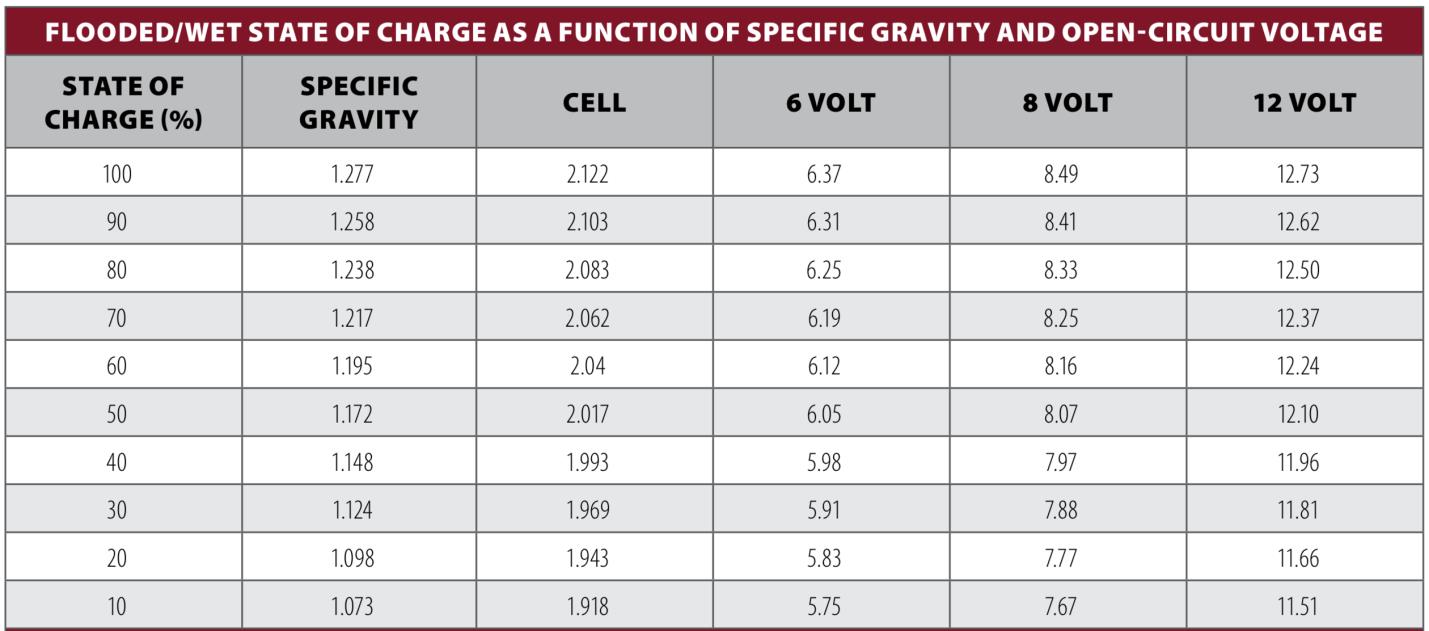
I only test my batteries with a hydrometer when fully charged. I have no need to test them when they are less than a full charge. Some things to remember:
- A battery should sit several hours after charging to stabilize. I let mine sit for 24 hours minimum.
- The only time you should add water is if the water level is low after it is charged. The one exception is when the electrolyte is low and the plates are showing, you need to add enough water to cover the plates and then charge it. Once the battery is charged, top off each cell until the level is full, then charge again. Anytime you add water, charge the battery again before testing. Only use distilled water.
- When testing each cell, take 3 or 4 samples, and then record the reading. Record the reading of each cell. If there is a variance of 0.050 between any cells, perform an equalization charge, let the battery sit for 24 hours and test again. If the variance is still 0.50 or more between any cells, it is time for a new battery.
- The specific gravity readings must be temperature corrected or a self-correcting hydrometer can be used. My hydrometer is not temperature corrected. I just use the ambient temperature and test after the batteries have been sitting in the shade for several hours.
Rules for temperature correction:
- For every 10 degrees over 80F, add 0.004 to your readings
- For every 10 degrees under 80F, subtract 0.004 from your readings
My hydrometer isn’t temperature corrected, so I will need to add points. The trailer had been sitting for two weeks with the battery switch disconnected, however I have wired my TriMetric directly to the battery bank so it works even with the battery bank disconnected from the trailer’s electrical system. When I got to the trailer the State of Charge was 12.8 volts and the ambient temperature was 100F.
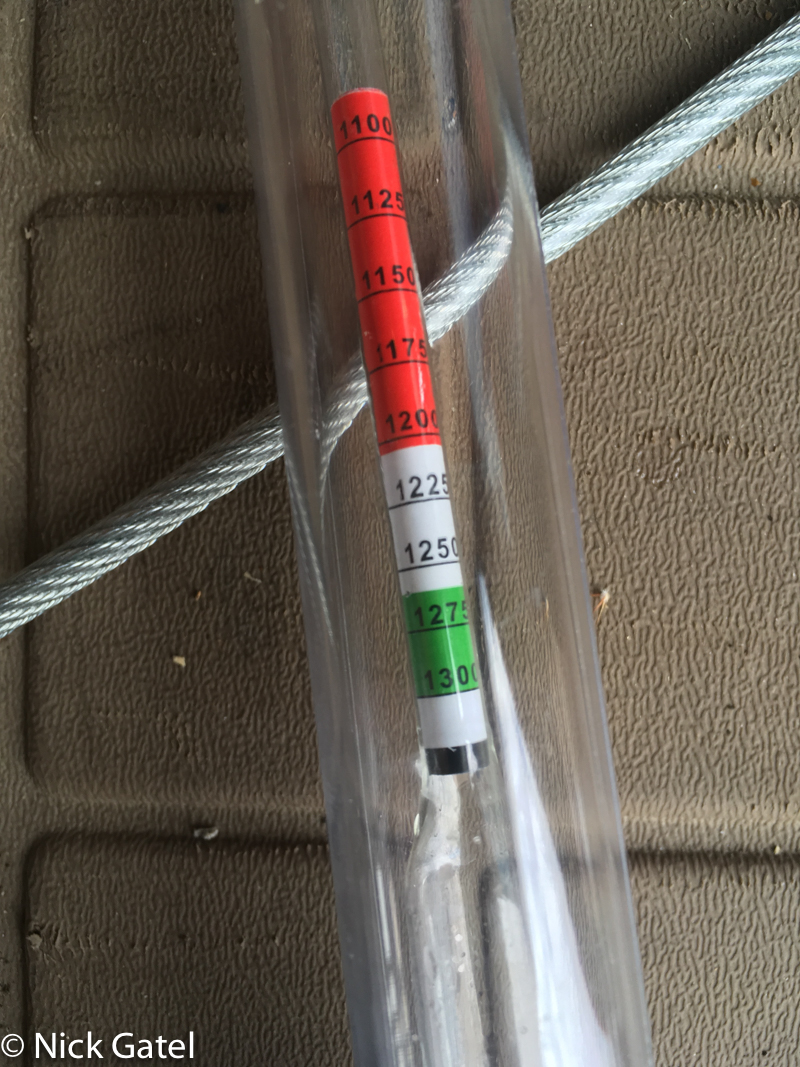
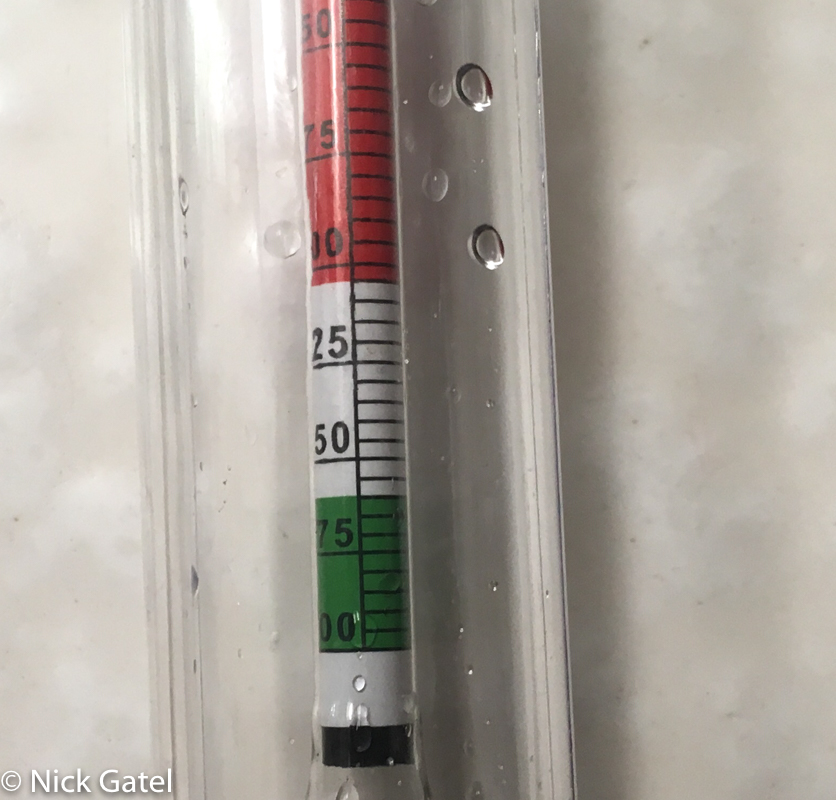
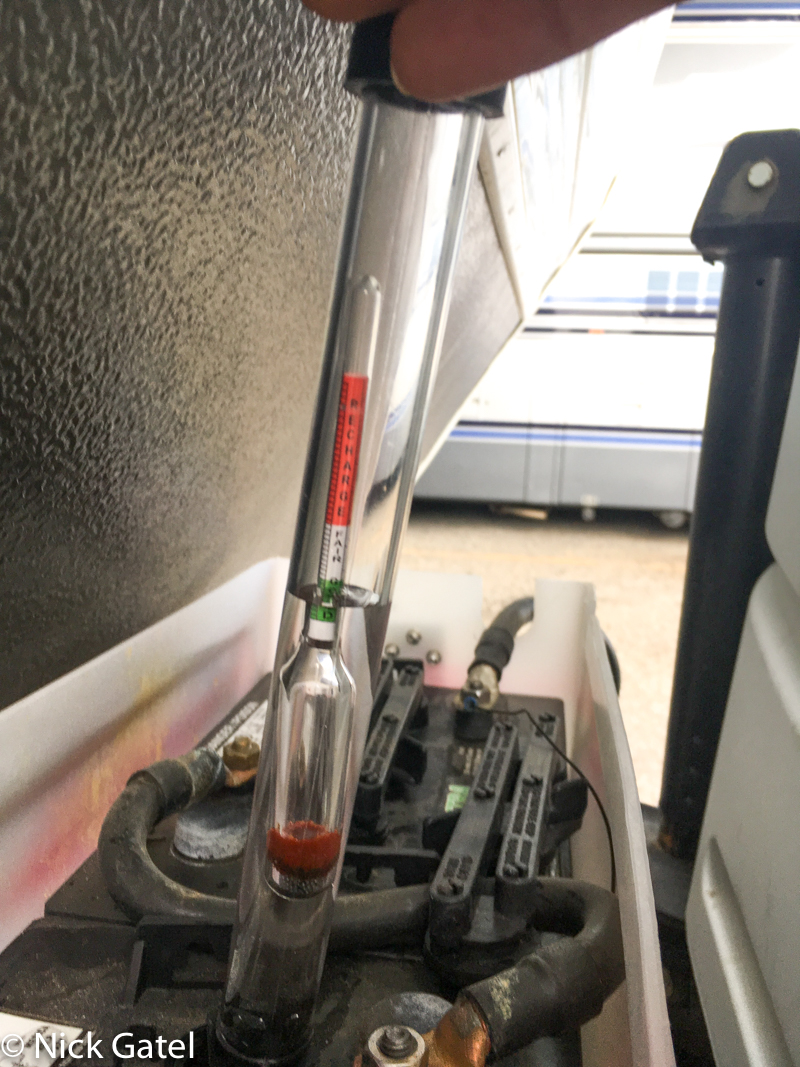
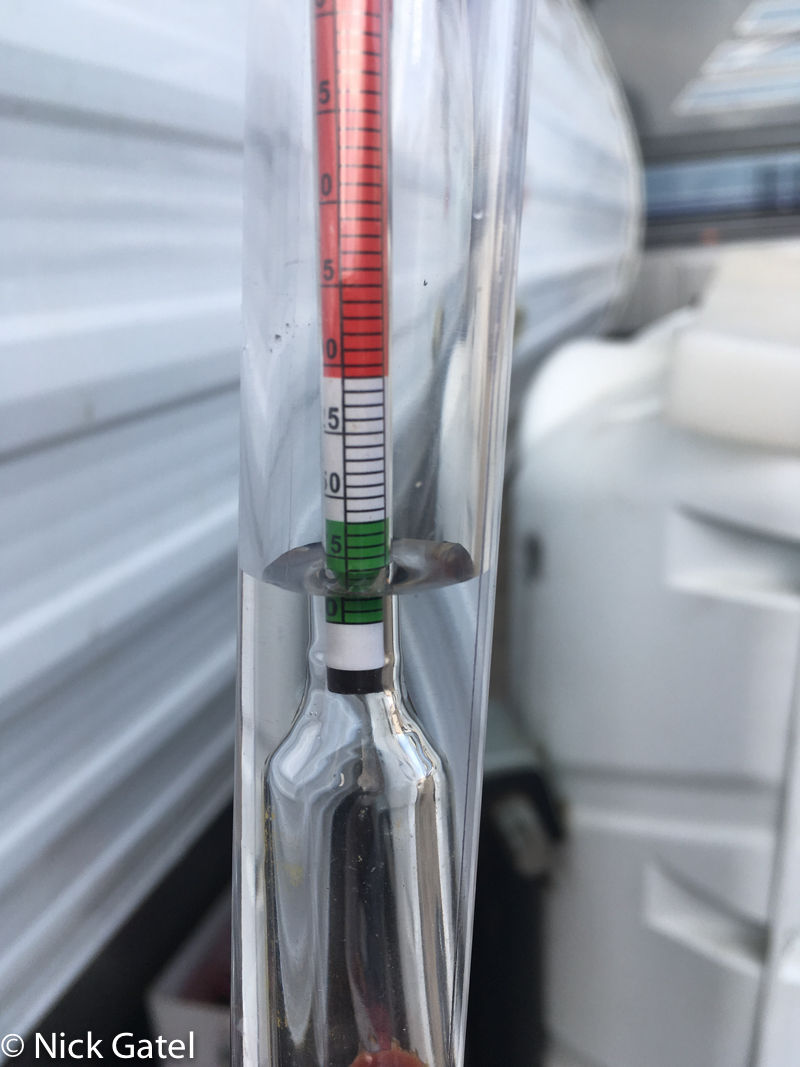
The reading is 1.280 and we need to add 0.008 because the ambient temperature is 20 degrees warmer than 80F. So the final reading is 1.288 and this was the average of all 6 cells with almost no variance. The battery is fully charged and doesn’t need equalization charge. The low discharge amp performance simply means there is too much internal resistance in the battery that is simply a function of age.
Deep Cycle Battery Charging Requirements
From the Trojan website:
Most deep-cycle applications have some sort of charging system already installed for battery charging (e.g. solar panels, inverter, golf car charger, alternator, etc.). However, there are still systems with deep-cycle batteries where an individual charger must be selected. The following will help in making a proper selection.
There are many types of chargers available today. They are usually rated by their start rate, the rate in amperes that the charger will supply at the beginning of the charge cycle. When selecting a charger, the charge rate should be between 10% and 13% of the battery’s 20-hour AH capacity. For example, a battery with a 20-hour capacity rating of 225 AH will use a charger rated between approximately 23 and 30 amps (for multiple battery charging use the AH rating of the entire bank). Chargers with lower ratings can be used but the charging time will be increased.
Trojan recommends using a 3-stage charger. Also called “automatic”, “smart” or “IEI” chargers, which prolong battery life with their programmed charging profile. These chargers usually have three distinct charging stages: bulk, acceptance, and float.
These are the Trojan charging specifications:
Why on earth doesn’t Exide publish all the required charge rates? You’ll notice there isn’t an equalization rate in the table below:
Interstate does provide all four rates:
Since we only charge our batteries with our solar system and our Morningstar TriStar solar controller can be programmed to meet the battery manufacturer’s specifications, life is good.
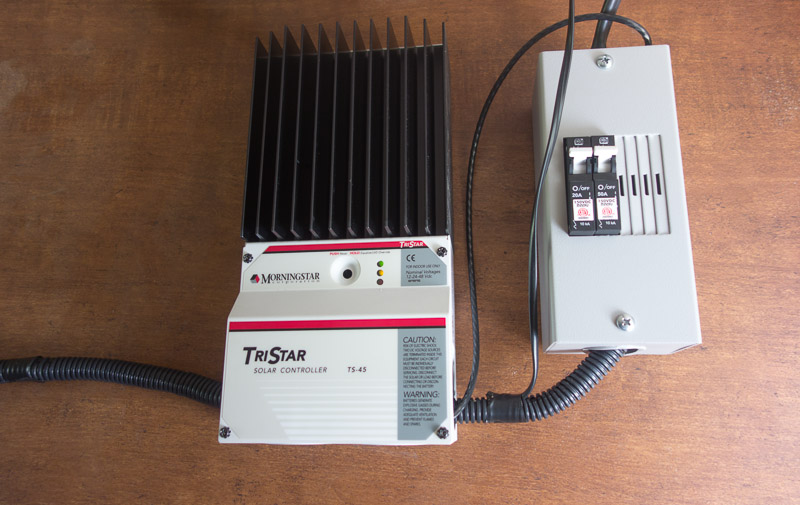
For more detailed information on battery charging this post, State of Charge: You Camper/RV May Be Killing Your Battery Bank.
I wish I could tell you there is an “off the shelf” battery charger that can charge a deep cycle battery at the required specifications. By “off the shelf” I mean one you plug into a wall outlet and connect to the battery just like the plethora of automotive chargers available. There isn’t one I have found. Almost all of them have a maximum daily rate of 14.4 volts, which is well below what most deep cycle battery manufacturer’s recommend. To be honest, a solar system isn’t for everyone either.
You can find battery chargers that put out 20 amps and meet the four charging specifications, but these are meant to be hardwired to a camper, or they are replacement units for a camper’s OEM charger/converter. One could take one of these chargers and add a 110 volt cord along with a pair of wired alligator clips to attach to the battery bank. I’m not going to get into how to switch over any of these units because you really need to know what the heck you are doing. If you feel comfortable making such a change, check out the Xantrex brand or a Magnum charger/inverter – just make sure you research all the specifications first.
Disclosure: I bought all of these items with my own money at the regular advertised prices. PopupBackpacker.com pays the bills through marketing links, receiving small commissions from vendors, at no additional cost to the reader. This post contains said links.
